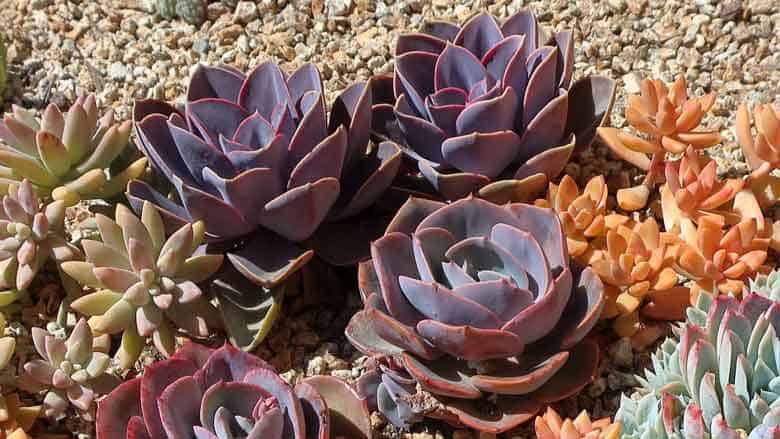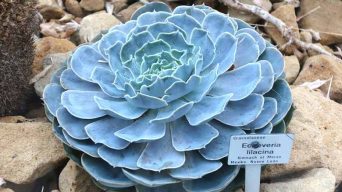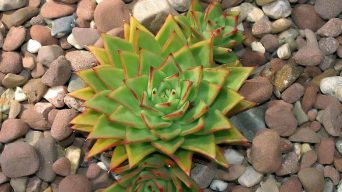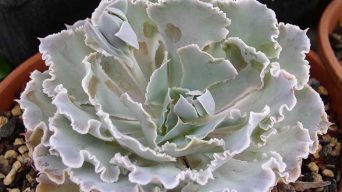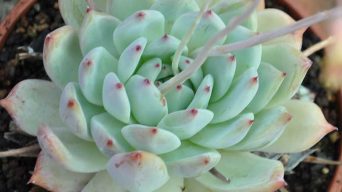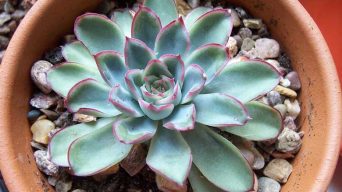For many years, Echeveria succulents have been one of the most popular plants among houseplant enthusiasts.
Echeveria ‘Purple Pearl’ is a beautiful addition to any home or office that requires low maintenance.
This article will cover everything you need to know about caring for and propagating your Echeveria ‘Purple Pearl’ plant.
Overview
The Echeveria ‘Purple Pearl’ is a popular Echeveria that belongs to the Crassulaceae family of succulents.
The Echeveria genus is distinguished by its flattened rosettes of fleshy leaves surrounding a compact central stem and thick roots that grow above ground in the form of tuberous networks.
Echeveria ‘Purple Pearl’ succulents can grow up to 12 inches in height. It has an interesting coloration ranges from dark purple to light lavender, with green in between.
The purple leaves are smooth and fleshy, making it an excellent choice for indoor or outdoor cultivation.
The flowers bloom around summer or early fall and can be red or pink.
Echeverias are found all over the world but originate from Mexico and Central America.
How To Care for Echeveria ‘Purple Pearl’
Sun Exposure & Light Requirements
The Echeveria Purple Pearl plants can thrive in a wide range of light conditions but prefer filtered bright light.
This succulent plant should be fine without supplemental lighting as long as it has at least four hours of sun exposure per day during summer.
However, if you live in an area with intense winter sunshine or wish to grow your plant indoors year-round, provide artificial light.
Use fluorescent lamps positioned 12 inches from plants for 18–24 hours daily (the equivalent of three full days).
Remember that too much sunlight will cause leaves to turn yellow and fall off; uproot such plants to a partial shade area before they suffer severe damage caused by heat stress.
Watering Requirements
Echeveria ‘Purple Pearl’ prefers to be watered sparingly, only when the soil is completely dry. Water the plant well, then allow it to dry out for several days.
It’s best to avoid getting any water on the leaves, or they may turn brown and fall off.
If too much moisture is retained, this can lead to root rot which could be fatal for your plants.
When you’re unsure if a plant needs watering, dig down into its soil about an inch (25 mm) with a finger.
If it feels moist at that level, don’t worry about it yet – but if it doesn’t feel like there is any moisture within 25mm of the soil’s surface, give some more water!
The plant will enter a semi-dormant state in winter and won’t need watering as often.
Soil
The best way to ensure your Echeveria ‘Purple Pearl’ gets the right amount of water and nutrients is to use well-draining soil with good air circulation.
Light potting soils are made specifically for succulents (a cactus or succulent soil mix). You can also use regular potting soil with some perlite mixed in.
Do not use heavy clay soil, as it will tend to stay wet, and your plant might rot.
It is also important that the pot you are using has a drainage hole in its bottom. If there isn’t one already, then make sure to drill or cut out one before planting your succulent.
If you don’t have a pot with a hole, put some gravel in the bottom. That will help stop the plant from sitting in water, and it will also dry out quickly.
Temperature and Humidity
The Purple Pearl is a succulent that thrives in warm weather.
If grown indoors, it should be given bright or indirect light and kept at an average temperature of 70-85 degrees Fahrenheit (20-30 Celsius) during the day, with temperatures dropping to 45-55 degrees F (12.75 – 13 C) at night.
This succulent thrives in a wide temperature range but will not take freezing conditions.
The humidity for this plant should be kept at 60-65%. If the air is too dry, mist it with water to increase moisture levels and reduce any damage due to dehydration.
Echeveria Purple Pearl care becomes much easier if grown outdoors because of its hardiness against extreme temperatures (-40 degrees Fahrenheit or -40 Celsius).
In colder climates where frost occurs during winter, it’s best to cover plants with sheets or bring them indoors until an expected warm spell passes through.
During very hot periods outside (above 100 degrees F), keep it out of direct sunlight if possible, as intense heat may cause sunburned spots on the leaves and stems.
Fertilizing Echeveria ‘Purple Pearl’
Echeveria ‘Purple Pearl’ is not a heavy feeder but enjoys some fertilization.
Feed once every two weeks during the growing season and monthly in winter.
You can use regular house plant fertilizer or slow-release pelletized fertilizer mixed into potting mix at half the recommended strength to minimize any risk of leaf burn from too much nitrogen.
Potting and Repotting
Plants that have been in pots too long will typically grow larger than their pot’s size, which can cause them to fall out or become overcrowded.
A sign that it may be time to repot a plant would be if roots are growing through drainage holes at the bottom of its container.
When potting a plant, it is best to use fresh soil. This will help with both aerating and watering the roots, as well as providing nutrients for them.
Be sure there are drainage holes in the bottom of the pot so excess water doesn’t accumulate inside and drown out your plants’ root systems.
Fill a container about halfway full with high-quality organic cactus mix (or similar material). Then place your Echeveria root ball on top of this mixture before covering it up entirely with more soil.
Ensure not to add too much fertilizer when preparing this new home for your purple pearl. Some may be useful later if new growth appears, but less is more during the initial repotting stages!
Pruning
Prune the dead leaves off of your Echeveria plant. If you notice that a leaf is getting brown around the edges, it’s time for some pruning!
Leave at least one or two pairs of leaves per stem so that new growth can come in through them.
Be careful not to remove too many – these plants are easily injured and take a while to heal.
The goal is to leave one or two sets (pairs) of leaves per stem so that new growth can grow through them for food and water absorption.
Pests and Diseases
Echeveria ‘Purple Pearl’ are susceptible to the following pests and diseases:
Diseases
Curly Top Virus
Aphids transmit this disease. The leaves turn yellow, then curl at the edges. Severe cases can lead to leaf drop.
There is no cure for the curly top virus, but it can be treated with insecticide treatments.
Sprays or horticultural oil can be used every few weeks, and you can also use warm water and dish soap to wipe down plants with sooty mold on them.
Crown Rot
A fungal infection that causes browning of plant tissue around the base of stems near soil level.
The stem may be twisted or brittle, and infected tissue will eventually die and fall off.
Root Rot
Caused by a range of fungi and bacteria.
Plants will appear wilted or have stunted growth, dry soil around the roots, browning near the base of the stem, and dark, moist patches on the roots.
Bacterial Leaf Spot
The most common diseases on succulent plants are typically leaf spots caused by bacteria such as anthracnose, chestnut blight, and phyllosticta.
Circular water-soaked lesions can identify these with concentric rings that eventually turn brownish in color.
To reduce risk, keep leaves clean to avoid splashing when watering. Use proper spacing so foliage doesn’t touch each other (airflow is critical).
Pests
Mealybugs
Like any other pest infestation, mealybugs will proliferate significantly if left unchecked.
They secrete honeydew that attracts ants (another type of pesky insect), protecting them from predators who want to feast on their sweet secretions.
Fungus Gnats
These tiny pests live underneath your potting mix, where they lay eggs among damp organic matter such as decomposing leaves or mulch.
If you see thousands of little black flies crawling near your succulents, those nasty gnats likely have laid eggs in your potting mix.
Spider Mites
Spider mites are tiny spider-like creatures that can nest in your succulent’s leaves and suck out their life juices.
If you notice tiny red dots or webs on your plants, it may be an infestation of these pests.
How To Propagate Echeveria ‘Purple Pearl’
Leaf Cuttings
Leaf-cutting is an easy and low-maintenance way to propagate Echeveria ‘Purple Pearl’.
Take a healthy, mature leaf from the plant and use a sharp knife or razor blade to slice off about one inch of it.
Ensure you get as close to the petiole base (the stem where leaves attach) without damaging any part of it.
Carefully remove all other fleshy material around this area with your fingers or tweezers so bare green tissue remains on both ends.
Let the cutting callus (dry out) for a few days, then place it in moist potting soil.
Be sure to water sparingly until you see signs of growth, usually within two months. But keep an eye on moisture levels as Echeverias need more than other succulents during propagation phases due to their fleshy leaves.
Offsets
The offsets, which are baby plants that grow from the mother plant leaf base and root off it, can be removed by simply pulling them away.
These will eventually develop into full-sized rosettes themselves.
These offsets should be removed from their mother and planted into the soil with adequate drainage, such as cactus potting mix or those specially designed to keep water from seeping out.
The container used can vary depending on how many you plant at once.
While pots work well, shallow containers often work better because they allow more room for new roots to grow, eventually supporting your plants.
Once the offsets have been planted into their own container, place them where there is plenty of sunlight so that they get a good start on growing strong stems and leaves.
Your Echeveria ‘Purple Pearl’ plant will thrive if provided ample amounts of light and water during this phase.
Seeds
Echeveria plants can be propagated by seeds.
Seeds are generally sown on a well-drained seed media surface and covered with about one inch (25 mm) of soil.
Seeds should be watered lightly to moisten the seeds, then kept in indirect light until germination.
The most common lag time for Echeveria ‘Purple Pearl’ is between three and six months when grown from seed.
Is the Echeveria’ Purple Pearl’ Toxic?
The Echeveria’ Purple Pearl’ is not toxic to humans or animals.
There are no reports regarding Echeveria being harmful to humans or animals. However, if you have pets (especially dogs), it’s best not to let them eat any part of an Echeveria plant.
Some plants may have mild side effects if eaten in large quantities, such as vomiting and stomach irritation, but these will wear off once you stop eating them.
Some people experience an allergic reaction on rare occasions, including rash/hives (usually pinkish-red), itching, swelling lips, tongue, or throat, wheezing, and difficulty breathing.
Final Thoughts
Echeveria ‘Purple Pearl’ plants are beautiful succulents that are incredibly low maintenance and hardy, making them perfect for any garden, indoors or outdoors.
If you keep them in a sunny area and provide water when the soil is dry, they should thrive with no problem.

